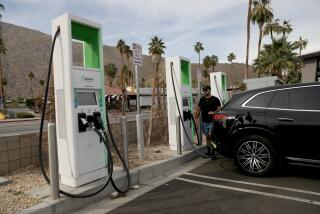GM’s Baby Will Leave Skeptics in the Dust
Any day now, General Motors’ sporty little electric roadster, the EV1, will reach Saturn showrooms in California and Arizona. As the first new kind of car from Detroit in about 90 years--and one that may improve air quality in smoggy cities, trim America’s dependence on foreign oil, even reduce synthetic carbon dioxide emissions that lead to global warming--the EV1 would seem to merit at least the benefit of doubt. Yet once again, the skeptics are in full cry.
The largest chorus emanates from Detroit, where the automotive press is based, though if you listen hard, you can hear the basso profundo of Big Oil in the background. The skeptics note that EV1’s range is just 70 to 90 miles, and that its batteries take at least three hours to recharge. They observe that the car would cost at least $35,000 if GM were to sell it rather than lease it, as the company intends to do. They argue that half as much money buys a low-polluting gas car with a 300-mile range and a refuelling time of three minutes. Even as a lease deal, the skeptics scoff, EV1 will have about three takers--Ed Begley Jr., Jackson Browne and Tom Hayden. Watching GM introduce the car, as one automotive reporter put it to me, is like watching an accident occur in slow motion.
In some stories of invention, the skeptics prove right. With this one, they’ve been wrong at every turn. In the late 1980s, they said electric vehicles would never be more than slow-accelerating clunkers. Yet the concept car that GM introduced in early 1990--EV1’s rough draft--zipped from 0 to 60 in less than eight seconds and sped to more than 80 miles an hour. That, the skeptics chorused, was a one-of-a-kind model GM could never produce. Now they can only say it has no market. I think they’re wrong again.
The range that appears to limit EV1’s market may be less of a problem even in the car’s first generation than its critics suppose: 1,200 urban drivers in a two-year marketing test across the country adjusted readily, without the infrastructure of public charging stations that GM is rushing to build in its debut markets. Moreover, the advanced nickel metal hydride battery from inventor Stan Ovshinsky, which GM hopes to include in its second-generation electric vehicles, is incredibly promising. There, the skeptics’ retreat has followed much the same pattern. An A-sized prototype battery might prove the science, they said, but could never be scaled up. Well, perhaps it could be scaled up, but it could never be produced. Well, perhaps it could be produced, but never cheaply enough to find a market. As the skeptics cling to that last barricade, the battery’s range continues to climb; last spring, an Ovonic pack took a four-door electric vehicle 375 miles.
Electric vehicles have been tarred by oil-backed lobbyists as impractically expensive. But that’s hokum. EV1 is more like the first laptop computer or cellular phone than the latest model from a mature industry where improvements are incremental and sticker prices inch ever upward. Like those recent marvels, much of EV1’a initial high cost is in its electronics. GM won’t say how much it can reduce those costs, but privately its engineers believe they can cut them by half in just two years.
My favorite jibe is the skeptics’ most recent one. Even if a market does emerge, they observe, GM seems sure to lose a bundle before it makes back a dime. Wait--aren’t those the same critics who attack U.S. companies for not looking beyond their quarterly statements to make long-term R&D; investments? The fact is that stolid, monolithic GM has done just that, committing not only money but much corporate prestige in a bold bid to seize the future with a car that’s 97% cleaner than the cleanest gas car, and one that is, in itself, a triumph, the best-designed small car in the company’s history.
So in the next weeks, as the skeptics moan in print, consider the source. Do the criticisms come from other car-makers, all of whom are working furiously now to ready electric vehicles of their own? Or from oil companies like Mobil, with its oh-so-earnest paid Op-Ed ads that get 90% of the facts right but subtly subvert the other essential 10%? Or just from grumpy gas-heads scornful of electric vehicles because of a first generation that, clean as it may be, fails to match in every way the polluting power of the internal combustion engine?
Then imagine these same skeptics at the side of a dirt road in, oh, 1902, as an early gas car roars by. That’ll never work, they mutter. How can it? It’s loud, it uses fuel that explodes, it’s got a crank that only the brawny can turn; and what’s its use outside the city, where there aren’t any paved roads or, for that matter, refueling stations?
EV1 arrives in a world with paved roads and a national power grid, propelled by space-age electronics and advanced lead acid batteries, to a market that wants it to succeed for the benefits it can bring.
This is a problem?






